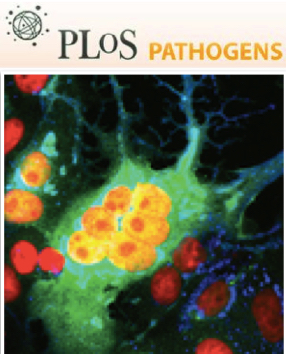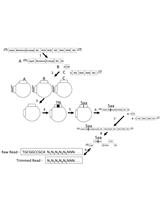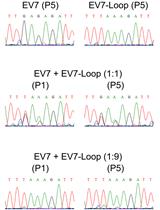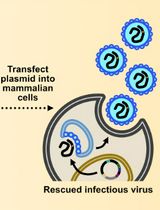- EN - English
- CN - 中文
Determining the Relative Fitness Score of Mutant Viruses in a Population Using Illumina Paired-end Sequencing and Regression Analysis
采用Illumina 配对末端测序和回归分析测定某种群中突变病毒的相对适应度分数
发布: 2015年05月20日第5卷第10期 DOI: 10.21769/BioProtoc.1475 浏览次数: 9295
评审: Arsalan DaudiMigla MiskinyteAnonymous reviewer(s)
Abstract
Recent advances in DNA sequencing capacity to accurately quantify the copy number of individual variants in a large and diverse population allows in parallel determination of the phenotypic effects caused by each genetic modification. This systematic profiling approach is a combination of forward and reverse genetics, which we refer to as quantitative high-resolution genetics (qHRG). This protocol describes how to determine the relative fitness score of each variant compared to wild type (WT) virus based on its frequency determined by Illumina sequencing. Random mutagenesis techniques will be used to introduce randomization at each codon position of the targeted region, thereby generating a comprehensive input mutant library with substitutions at each position of interest (Qi et al., 2014; Wu et al., 2014a; Wu et al., 2014b). After selection, each selected library will be sequenced by Illumina paired-end sequencing and the frequency of each mutation will be determined. Based on the change in frequency, the relative fitness score of each mutant can be calculated with regression analysis.
Materials and Reagents
- The Huh-7.5.1 cell line (kindly provided by Dr. Francis Chisari from the Scripps Research Institute, USA)
- Dulbecco's modified Eagle medium (DMEM) (Corning, Cellgro®, catalog number: 10-017-CV )
- Fetal bovine serum (FBS) (Omega Scientific, catalog number: FB-11 )
- 100x non-essential amino acids solution (Life Technologies, catalog number: 11140050 )
- 1 M HEPES (Life Technologies, catalog number: 15630080 )
- 100x Penicillin-Streptomycin-Glutamine (Life Technologies, catalog number: 10378016 )
- 10x trypsin supplemented with EDTA (Life Technologies, Gibco®, catalog number: 15400054 )
- Plasmid that carries the HCV viral genome (pFNX-HCV) was synthesized based on the chimeric sequence of J6/JFH1 virus
Note: In this protocol, we are taking the HCV NS5A mutant library as an example to describe the procedures to relative fitness determination (Qi et al., 2014). A mutant virus library where each codon of interest was individually substituted with ‘NNK’, where N represents random incorporation of A/T/G/C; K represents random incorporation of T/G. The randomized codons therefore include 32 nucleotide combinations, which cover all possible amino acid. - 100% ethanol (Decon Labs, catalog number: 2701 )
- QIAamp Viral RNA Mini Kit for viral RNA purification (QIAGEN, catalog number: 52906 )
- Sterile, RNase-free pipet tips (with aerosol barriers for preventing cross-contamination) (OLYMPUS, catalog numbers: 24-401 , 24-404 , 24-412 , 24-430 )
- SuperScriptTM III Reverse Transcriptase Kit (Life Technologies, InvitrogenTM, catalog number: 18080-044 )
- RNaseOUT Recombinant Ribonuclease Inhibitor (Life Technologies, InvitrogenTM, catalog number: 10777-019 )
- KOD Hot Start DNA Polymerase Kit (Novagen®, catalog number: 71086-4 )
- PureLink® Quick PCR Purification Kit (Life Technologies, InvitrogenTM, catalog number: K3100-02 )
- T4 Polynucleotide Kinase (PNK) (New England Biolabs, catalog number: M0201S )
- NEB buffer 2 (New England Biolabs, catalog number: B7002S )
- dATP (100 mM) (Life Technologies, InvitrogenTM, catalog number: 10216-018 )
- Klenow Fragment (3’ to 5’ exo-) enzyme (New England Biolabs, catalog number: M0212S )
- T4 DNA Ligase Kit (Life Technologies, InvitrogenTM, catalog number: 15224-017 )
Equipment
- 15 cm cell culture dishes (Genesee Scientific, catalog number: 25-203 )
- T-150 cell culture flasks (Genesee Scientific, catalog number: 25-211 )
- 37 °C, 5% CO2 cell culture incubator
- 1.7 ml Microtubes (1.5 ml) (Genesee Scientific, catalog number: 22-282 )
- Falcon 50 ml tubes (Corning, catalog number: 14-432-22 )
- Falcon 15 ml tubes (Corning, catalog number: 05-527-90)
- Microcentrifuge (with rotor for 1.5 ml and 2 ml tubes) (Eppendorf, model: 5424 )
- Centrifuge (with rotor for 15 ml and 50 ml Falcon tubes) (Thermo Fisher Scientific, Legend RT)
- NanoDrop ND-1000 UV Spectrophotometer (Thermo Fisher Scientific)
- Thermal cycler (Eppendorf, catalog number: 950030050 )
Procedure
文章信息
版权信息
© 2015 The Authors; exclusive licensee Bio-protocol LLC.
如何引用
Qi, H., Olson, C. A., Wu, N. C., Du, Y. and Sun, R. (2015). Determining the Relative Fitness Score of Mutant Viruses in a Population Using Illumina Paired-end Sequencing and Regression Analysis . Bio-protocol 5(10): e1475. DOI: 10.21769/BioProtoc.1475.
分类
微生物学 > 微生物遗传学 > 诱/突变
系统生物学 > 基因组学 > 测序
分子生物学 > RNA > RNA 测序
您对这篇实验方法有问题吗?
在此处发布您的问题,我们将邀请本文作者来回答。同时,我们会将您的问题发布到Bio-protocol Exchange,以便寻求社区成员的帮助。
Share
Bluesky
X
Copy link













